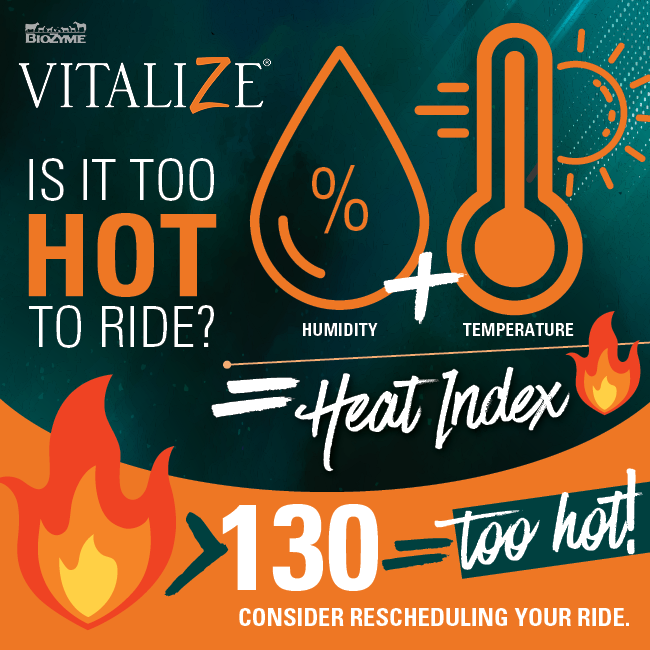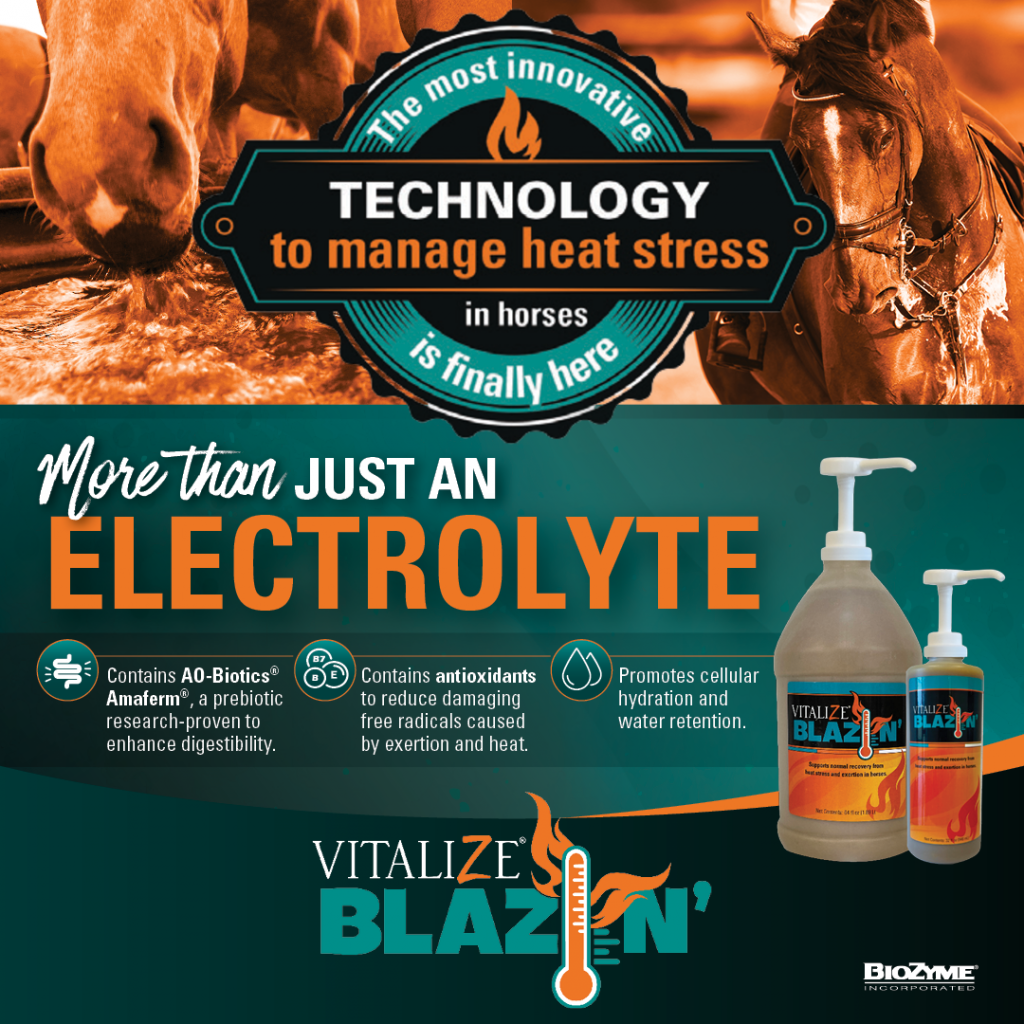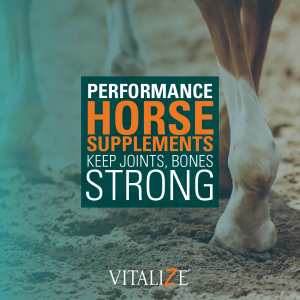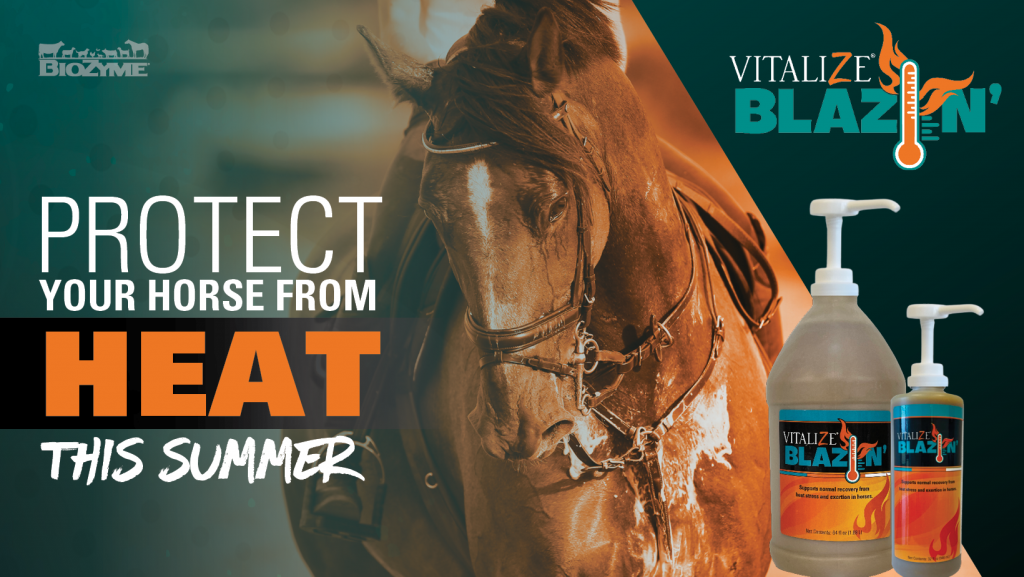
As the summer lingers, temperatures continue to heat up across the country. Just like humans don’t enjoy heat and humidity, your equine companion also has a certain threshold for heat.
Horses have a natural ability to handle extreme temperatures when kept within the upper and lower limits of their comfort zone, known as the “thermoneutral zone.” This means horses can maintain a normal body temperature without expending excess energy for heat dissipation or generation when the temperatures are between 40- and 80-degrees Fahrenheit.
Once temperatures reach 80 degrees or hotter, horses will likely experience heat stress. Heat stress occurs when the horse’s normal cooling mechanisms are not able to easily overcome the heat and humidity in the environment. If left untreated, the process of heat stress can lead to heat stroke, which can be life-threatening. But how can you tell? Here’s what you should know about heat stress in horses.
Signs of Heat Stress in Horses
Watch for these six tell-tale signs of heat stress in your horse when temperatures heat up or during heavy work in the summer.
1. Excessive Sweating
Horses, like humans, use a cooling process where moisture evaporates from the skin, referred to as sweating. Sweating is a good thing. However, if your horse works up a rich lather, they may be working too hard to remain cool, which is a sign to stay alert in the heat.
Important note: sweat has a harder time evaporating during high humidity levels. That is why it is vital to take into consideration the heat index, not just temperature alone, when caring for your horse during summer.
2. NO Sweating
Conversely, some horses suffer from anhidrosis. Anhidrosis occurs when horses do not sweat adequately, causing a build-up of internal heat and increased body temperature. This can sometimes reach upwards of 110° F.
While the direct cause of anhidrosis is unknown, many experts associate it with the over-stimulation of sweat glands due to environment or exercise stress hormones. This overstimulation causes the glands to shut down. Others suggest it could be a byproduct of metabolic or hereditary conditions or a lack of electrolyte replenishment. Whatever the cause, this insufficient body temperature regulation decreases the horse’s ability to perform and also puts it at risk of hyperthermia and heat stroke.
If you have a non-sweater, you should always be on high alert for your horse’s health in the heat.
3. Rapid Respiratory & Heart Rate
It is challenging to see an increase in heart rate without taking vitals, but an increase in respiratory rate is usually easy to spot. Look to see how your horse’s nostrils are flaring as they breathe. If your horse is flaring its nostrils for longer than normal during cool down, it could be at risk for heat stress.
Always pay attention to how hard your horse is breathing before starting training again or heading back to the barn. In the most stressful, hot days, add a couple more laps at the walk to help your horse cool down after working.
4. Dehydration
When your horse is under heat stress, it may become easily dehydrated due to excessive sweating. During the hottest days, the water requirement for horses increases from 6-10 gallons to nearly 15 gallons per day. Supplement a product with salt, sugar or added electrolytes to encourage adequate drinking to help maintain the water requirements under these conditions.
5. Decreased Gut Sounds
Because your horse’s body is using the sympathetic nervous system (aka the “fight or flight” response) to address its high heart and respiratory rate, its parasympathetic nervous system (aka the processes used at rest, such as digestion) slows down. During prolonged periods of heat stress, your horse could show decreased gut sounds, putting it at a higher risk for colic and digestive upset.
6. Stumbling or Depression
If the signs are unaddressed, heat stress in horses can worsen into heat stroke. This is a more serious condition often first shown as stumbling, dizziness or depression in the horse. If you see this behavior, contact your veterinarian immediately.
Since heat stress can be harmful to your horse’s health, monitoring the outdoor temperature, humidity and your horse’s activity level in these summer months is crucial. Fortunately, Vitalize® has also created an innovative product to help manage the impact of heat stress in horses.
Vitalize® Blazin’ is a liquid product for horses designed to support normal recovery from heat stress and exertion. It contains a proprietary blend of ingredients to support blood flow and dissipation of body heat. It also contains AO-Biotics® Amaferm®, a prebiotic research-proven to enhance digestibility.
In addition, Blazin’ contains antioxidants to reduce damaging free radicals caused by exertion and heat. It also promotes cellular hydration and water retention.
A Safe Solution for Heat Stress in Horses
Vitalize Blazin’ is one of four Vitalize products that has recently earned Clean Sport Certification, meaning it has been tested and does not contain any prohibited substances for horses that compete under FEI, USEF or IFHA rules. In addition, Vitalize products carry the National Animal Supplement Council (NASC) seal, meaning their quality is third-party confirmed.
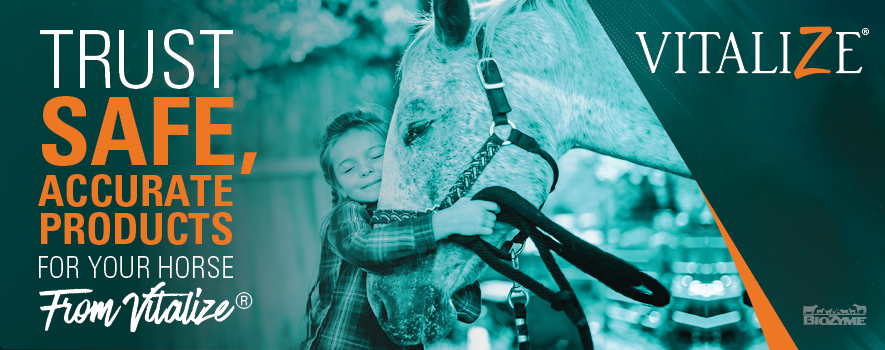
Don’t Take Our Word for It
“I’ve seen really good results with Vitalize® Blazin’. My jumping horse is a big, lazy horse and just everything about him is slow. I’ve tried so many energy products just to give him a little more oomph, and some things will work a little bit and some things don’t work at all, but Blazin’ has worked really well on him. He responds super well to it, and I’ve actually used it in all different types of weather,” said professional show jumper Darby Pease.
“In the hot weather, it gives him some extra energy and helps him recover so much faster after rounds and between the first round and the jump off. In cold weather, it gave him extra energy too. It just gives him a little bit extra fire, and overall makes him feel better. I give him one or two pumps on top of his feed morning and night, and he eats it great. He’s kind of picky, but he does really like it, which is good. It’s helped him reach his potential because he has enough energy to get around the big jumps.”
Be Proactive with Blazin’
It’s important to address heat stress in horses as soon as you identify it. But the best way to address the risk is to be proactive with preventative care.
Vitalize Blazin’ is available in two convenient sizes, both a 32- and 64-ounce bottle with easy to use pumps. Use as needed during elevated temperature or exertion and administer 2 to 4 pumps (30 – 60 mL) per day based on the intensity of heat and exercise. For best results, split the dose between morning and evening feedings. Best results will be obtained after at least three consecutive days of use.
To purchase Vitalize Blazin’ or find more Vitalize products, visit Buy Vitalize. Want more information on how to support your horse year-round? Sign up for BioZyme eblasts!

